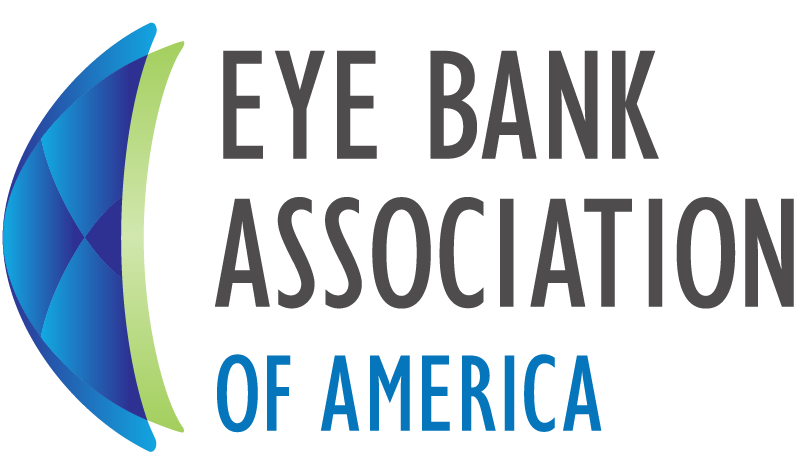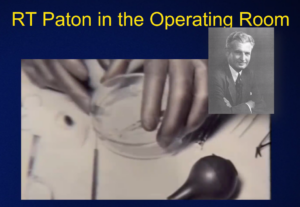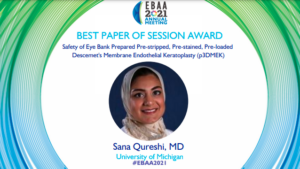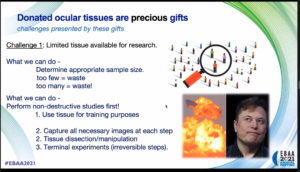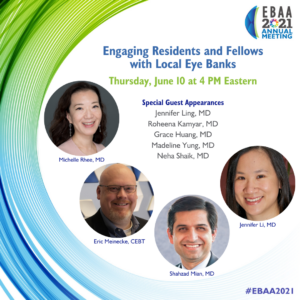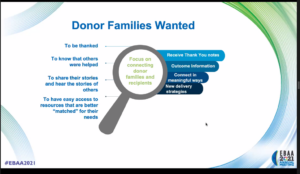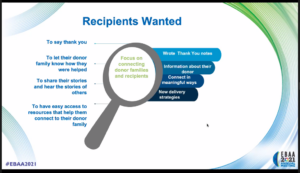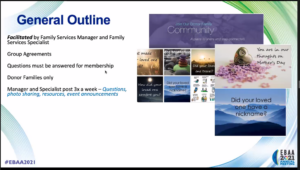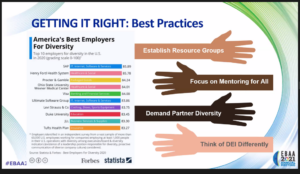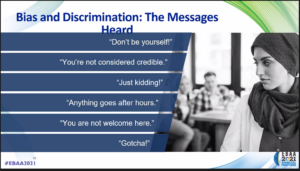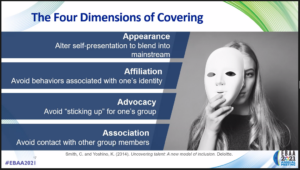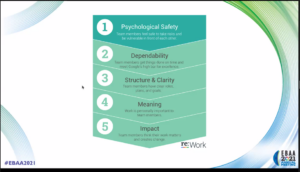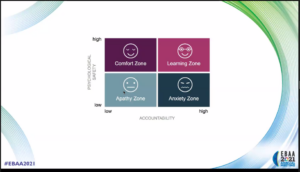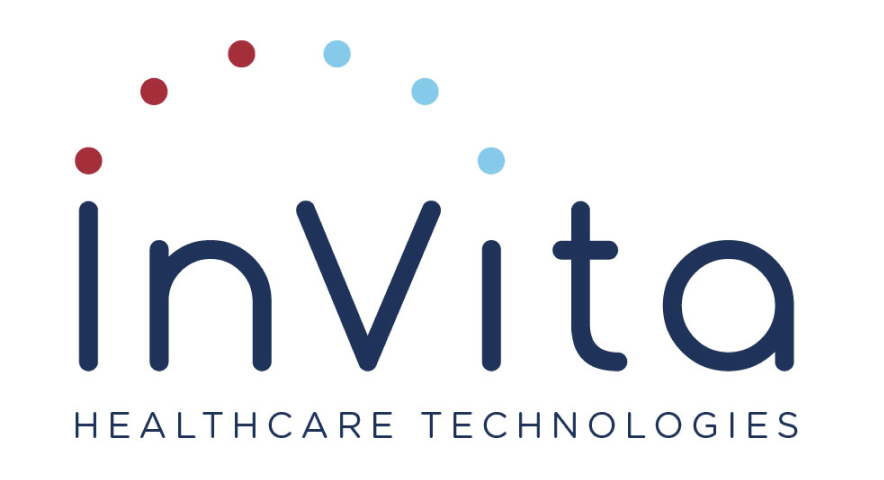Enjoy Highlights and recaps of #ebaa2021 sessions.
most sessions were recorded and are
available on-demand along with presentation slides. .
Saturday, June 12, 2021 – Scientific Symposium
R. Townley Paton: A Portrait in His Own Times, in His Own Words; Mark Mannis, MD
(Not Recorded)
 Dr. Mark Mannis talked about the history of eye banking and the “Father” of eye banking, R. Townley Paton. He shared films of R. Townley Paton discussing eye banking and corneal transplantation including:
Dr. Mark Mannis talked about the history of eye banking and the “Father” of eye banking, R. Townley Paton. He shared films of R. Townley Paton discussing eye banking and corneal transplantation including:
- Early cornea surgeries
- Paton in the operating room
- Post-operative course
Besides corneal surgery, Paton’s biggest contribution was the establishment of organized eye banking. Recordings revealed how difficult it was to obtain donated tissue, and how controversial the opening of the first eye bank was. Tissue was often recovered from prisoners who were asked to make a final contribution to humanity by donating their corneas.
R. Townley Paton is remembered fondly as a surgeon, teacher, and public servant.
The remainder of the information on the Invited Sessions and Scientific Abstract Presentations can be found in the Symposium Program. The abstracts will also appear in a future edition of the International Journal of Eye Banking (IJEB).
Congratulations to Best Paper of Session Award winner, Sana Qureshi! This is presented to a medical student, resident, Fellow, or eye banker. It is supported by an unrestricted educational grant from IJEB.
Friday, June 11, 2021 (Day 4)
Keynote: The Needs and Challenges of Using Ocular Tissue and Cells in Cell-Based Therapies
Technical Skills Workshop
Donor Tissue Evaluation: Current and New Technologies
Today’s sessions were highly technical, and involved the use of images and video of tissue for observation and evaluation. The slides are all available in the agenda section of the meeting website, and recordings of the sessions are available on-demand.
Thursday, June 10, 2021 (Day 3)
Research and Surgical Innovation: The Lasting Impact of Ocular Donation; Sponsored by Ocular Therapeutix
An engaging panel of speakers discussed the research element of eye banking. The session began with a brief history of corneal transplantation / eye banking and the innovations along the way. The future includes:
- Endothelial surgeries
- Drone delivery of corneas
- Whole eye transplants
- Bioengineered corneas and retinas
- 3D printing of corneas
Research Programs / Efforts at Eye Banks
Research donation is mission critical – and part of an eye bank’s strategic plan. Research is an attractive factor which encourages people to donate – it is critical to properly communicate the benefits of scientific donation to the public. Science can seem distant and take too long, so the need is to make it relatable. Avoid “guy at the microscope” imagery – focus on those who benefit. Explain why human eye tissue is needed – “lead with the need,” humanize, focus on IMPACT. Every surgical procedure and medical innovation was once a research project.
Communities are not monolithic. You need to build TRUST and adjust communications to individual communities.
When donor families find out their loved one’s cornea gift went to science, there can be some mixed feelings. It’s important that donor families know the value of that scientific gift and the importance of research. The donation of corneas to research is not a consolation prize.
Tissue comes from donors and donor families. Using it makes researchers better and more driven to create helpful innovations for the future.
Afternoon Session 1: US Regulations for Regenerative Medicine and Advanced Therapies
Attorney J. Seth Olson delivered a detailed presentation about 361 HCT/P human cells, tissues, and cellular-based products – along with FDA’s oversight requirements for them. A recording of his presentation is available, along with the slides he used.
Afternoon Session 2: Reignite Your Life: How to Manage Stress, Prevent Burnout, and Perform at PEAK Levels
Eye banking has an emotional component, which is an added workplace stressor, even without a global pandemic. Factoring in COVID-19, feeling burned out (or the onset of burnout) is being experienced by most people – especially in healthcare.
Burnout includes:
- feelings of exhaustion
- increased mental distance from job or cynicism
- reduced professional efficacy
What have you done for YOURSELF lately to reignite your life? Daily? Weekly? Monthly? Create a self-care contract with yourself.
Adopt PEAK mindset:
- Present
- Exceptional
- Anxiety Managed
- Kick butt
There are small, simple things you can do each day to ward off stress:
- Splash cold water on your face
- Listen to a playlist of songs that perk you up
- Take 5 minutes to read an inspirational quote or uplifting video
Afternoon Session 3: Engaging Residents & Fellows with Local Eye Banks
Eye banks help generate interest in corneal surgery. Residents and Fellows are often unaware of what goes on “behind the scenes.” The earlier these eye bank / resident & fellow relationships form, the better.
To get started:
- Identify an eye bank point person / liaison
- Get on the resident lecture schedule
Eye Banks should host an “Eye Bank Experience” program for residents and fellows, inviting them to spend a day at the eye bank learning the daily functions and complexities of recovering and preparing tissue.

Wet labs are sought after by residents and fellows. They can be done both in person and virtually.
Residents generally come back from eye banks impressed and surprised by how much goes on at the eye banks, including research opportunities. Residents and fellows will want to participate in eye bank activities, but they need to be aware of these opportunities – research, funding, training, publishing, leadership roles, etc.
Wednesday, June 9, 2021 (Day 2)
Keynote Session: Embedding a Culture of Innovation Into Everyone’s DNA with Duncan Wardle
(Not recorded)
Duncan led us though a fast-paced, inventive presentation with creative break-out rooms designed to stretch our thinking and imaginations – and showed us new ways brainstorm and expand ideas.
 Innovation is a, “habit of continually doing things in new ways to make a positive difference in our working lives.”
Innovation is a, “habit of continually doing things in new ways to make a positive difference in our working lives.”
- It’s important to make new habits
- Innovation feels (and should feel) awkward
In discussions ask, “Could you help me think about this in a different way?” During presentations, skip PowerPoint, and have the presentation laid out on the wall. Take a “walk” through the presentation. This creates conversation instead of judgement.
- Don’t judge on work, build on ideas.
Some of the most creative people have the least resources – forces innovation.
When coming up with ideas, use less “no, because…” language and more “yes, and…” statements. You can always take a big idea and scale it down. It’s much harder to take a small idea and build it up. Using “yes, and…” transforms the idea from “mine” to “ours.”
Very few ideas come while AT work. The #1 barrier to innovation is: No time to THINK. Our brains are constantly in (busy) beta mode, we need to get them into (amazing) alpha. Working in even numbers of people – four is ideal – balances extroverts and introverts so that everyone can take part and be heard. Remove tables between people to have “comfortably uncomfortable” conversations. Using a “t-sheet” for recording ideas appeals to all three styles of learning: visual, auditory, kinesthetic.
Our “river of thinking” is our own experiences and biases. Need to break that river to get the best ideas. Add a “naïve expert” to the group – a person who is not in the industry, to add their insights. “Diversity is innovation. If someone doesn’t look like you, they don’t think like you, and they can help you think differently.”
To be innovative human beings we need fresh stimuli in our lives:
- Take a different commute to work
- Have monthly brown-bag lunch sessions with rotating guests
- Once a month have a day with no meetings, presentations, deadlines – giving people time to THINK
- Embrace artificial intelligence technology. Those with creativity, intuition, imagination, and curiosity will be the most valuable assets of the future
“The opposite of bravery isn’t cowardice, it’s conformity.”
Afternoon Session 1: Meaningful Aftercare Programs: Supporting Families After Donation
This session focused on ways to show gratitude to donor families, stay connected to them, and make sure they’re aware of the difference that has been made by their loved one’s donation.
Aftercare Programs, New England Donor Services
Is your aftercare program still relevant?
Focus groups were used to solicit feedback from overall aftercare program to understand expectations and attitudes from both donor families and recipients.
Both groups want meaningful connections with each other – this became the new focus of the Aftercare program, now called “Caring Connections.” Developed new priorities based on personal connections with families, and changed the website to add testimonials, videos, and electronic care cards.
Donor family medallions were redesigned and distributed to donor families. Focus was placed on events with more “celebratory” tones. New methods and focus proved to be effective, with more meaningful connections documented in 2020.
Support Programs: Grief is As Unique as Your Own Thumbprint, Dakota Lions Sight and Health
“Nobody wants to know what you know, until they know you care.”
Support and understanding:
- One on one contact
- Scheduled support events
- “Help families” – explaining how important the donation is to recipients
Physical reminders of loves ones: “Tree of remembrance” in office. Stained glass tears for families to place in window. Personalization of contact – on letters, etc. impacts how they view donation. “Positive communication.”
Find your way to be unique with your personal contacts and donor recognitions. Personal phone calls and mailings get donor families to attend the recognition events.
On phone calls – it’s not always what you say, but HOW you say it. Attempt to make each call unique and special. Do no underestimate the power of reaching out. Try to be:
- Slow
- Gentle
- Clear
When placing calls to donor families, remember to take care of yourself. Go for a walk, clear your head. Take a break. You can’t fake compassion to a grieving person, be patient with yourself and the family.
Donor Family Facebook Page: Creating Community, SightLife
Private Facebook page purely for donor families. Facilitated by Family Services Manager and Family Services Specialist.
The page functions as a safe space for healing, sharing, celebrating, and supporting. Helps create community and connection circles (gatherings, book clubs, craft nights), ambassador building, story creation, and hope and healing.
Celebration of Hope & Renewal, Iowa Lions Eye Bank
Takes place at the donor memorial garden in Iowa each year, usually in May. Includes a keynote, musical performances, donor and recipient stories. Remembrance benches or pavers are available and dedicated. Donate Life flag serves as the “guestbook” and each attendee signs it.
Memorial Blanket, Miracles in Sight
How can we best reach all of our donor families, who can’t all drive long distances? Had an idea for an afghan blanket to send to the families, one of which hangs in the entrance way of Miracles in Sight. Response from families has been overwhelming.
Afternoon Session 2: Diversity, Equity, and Inclusion: The Lever to Competitive Advantage
Delight Deloney led this session on Diversity, Equity, & Inclusions (DN&I). Everyone has a diversity story, and it benefits you and your organization to make the effort to be a more diverse, equitable, and inclusive workplace.
We’re all in this together, and we all have a role in making it better. Broad definition of diversity beyond race, gender, sexuality, religion, age, etc.
- Organizational
- External
- Internal
- Personality
Need to build a diverse foundation, and it starts from the top. You can’t just focus on diversity alone, inclusion actually yields the better outcomes. Inclusion is the key. Diversity is asking someone to a party. Inclusion is asking them to dance, and inquiring what music they like so that the DJ can play it. You’re making them comfortable so they can enjoy the party.
Micro Aggressions – a slight that demeans or marginalizes the recipient. Often come from unconscious bias. Can be unintentional, but have an impact on the receiver. People using microaggressions might not understand the impact, but intent is irrelevant, it’s the impact that counts.
Often individuals can feel as if they have to assimilate when the environment isn’t inclusive. Covering is a mode of de-emphasizing their identity group and can cause the employee to disengage from their workplace. It can lead to:
- Burning out
- Busting out
- Blowing up
Tuesday, June 8, 20201 (Day 1)
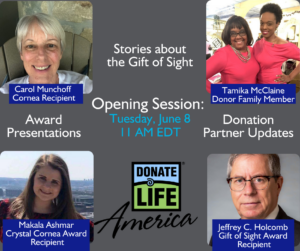 Opening Session Sponsored by Donate Life America
Opening Session Sponsored by Donate Life America
The EBAA 2021 Annual Meeting kicked off with an opening session that celebrated ocular donation and our community of compassion.
Highlights include:
- Welcome from EBAA President
- The Chair’s Address
- Our Why: Personal accounts about the gift of sight
- Presentation of the Crystal Cornea Award and the Gift of Sight Award
- Updates from our partners in donation:
- Donate Life America
- The Association of Organ Procurement Organization
- The American Association of Tissue Bank
EBAA President & CEO Kevin Corcoran opened the EBAA 2021 Annual Meeting by showing appreciation for the EBAA Board of Directors and all the sponsors who make #EBAA2021 possible.
EBAA Chair, Noel Mick talked about 2021 being the 60th Anniversary of EBAA, and reflected on the beginnings of the Association, but also EBAA’s focus on the future. Member eye banks supplied tissue for more than 66,000 transplants in 2020 – a considerable number, even with COVID-19 impacting the ability to conduct surgeries.
Our “Why” portion of the session was introduced by Tony Bavuso of Saving Sight
Tony shared two touching personal stories to remind us why we do the work to #RestoreSight using the principle of “accountable stewardship” – doing everything to make sure that the wishes of donors and the donor’s family are fulfilled. We must be accountable for handling the stewardship of sight in the most responsible way possible.
He introduced Tamika McClaine, the daughter of an eye and tissue donor who now shares her mother’s story as part of her life’s work. She writes and speaks about her own experience with grief and loss to help others in their grieving process, and started the campaign #LiveLikeBarb to honor her mother. Tamika now works at Saving Sight (today was her first official day!) She shared that her mother made decision years ago to be a donor. She always said, “you can’t take it with you,” as her reasoning for being a donor. She was generous, and a true “giver” in all aspects of her life. Tamika says, “There is purpose in loss,” and she carries that mantra with her in her work with Saving Sight. In this way, her mother lives on.
Carol Munchoff, a bi-lateral cornea transplant recipient underwent her transplants last summer during the midst of the COVID-19 pandemic. Carol had fuchs dystrophy – which was like looking through a “dirty windshield.” She tried to manage the condition with saline eye drops, but things got considerably worse – even leading to experiencing physical pain in her eyes.
She describes her transplant results as, “Like Dorothy opening the door to OZ” – everything was clearer and brighter! She went from barely seeing to brilliance in a matter of days. She no longer needs glasses or reading glasses, and is so thankful for her donor. Carol said, “This donation did not save my life, but it saved my quality of life… it has saved my entire being!”
Few eyes were dry behind computer screens, and the response from attendees was significant, with a flurry of messages. One in the chatbox said, “This really helps me getting up to go to work every morning.”
From there, Kevin presented the State of the Association Address. He spoke about:
- EBAA’s new Accreditation campaign, launched with an outside PR firm. “Safety First. Innovation Always” is aimed at physicians to explain the importance of non-profit eye banking and EBAA’s gold-standard Accreditation program.
- Legislative Advocacy, with new law in passing in Kentucky, it is the 1st state banning for-profit entities from recovering tissue. EBAA is ready to support eye banks in other states with these kid of advocacy efforts.
- Eye Donation Month, “Community of Compassion” continues for 2021. Based on feedback from the membership, we’re hoping to produce 3 videos for this year’s efforts.
- Technology Upgrades:
- E-STatIS
- The Lens
- Revised Member Portal
- Website Update
- EBAA 60th Anniversary, we continue to celebrate how EBAA has made innovations and advancements in the field of eye banking
The EBAA staff and Board of Directors are honored to work with the membership in the shared mission to #RestoreSight worldwide!
Updates from Partner Organizations:
Donate Life America Update: Dave Fleming
Looking to build a culture in the US where organ, eye, and tissue donation is a responsibility. Try to share stories everyday, always looking for cornea stories to share and reach new audiences.
Donate Life Month (April) was very successful, especially on social media. Added Donate Life Living Donor Day on April 7th, for the first time. Also new was Blue & Green Spirit Week. (DLACommunity.net for access to resources and content). Blue & Green Day photo contest. National Pediatric Transplant Week.
Living Donor Registry & Testing Initiative is a current focus. Grant from Novartis to do multicultural research. Over 60% of cornea donors are authorized through national registry or state registry partners.
AOPO: Steve Miller
Goal of 50,000 organ transplants by 2026. This is a 50% increase over the next 5 years. Key initiatives: Collaboration, Health Inequities, Organ Utilization, Innovation.
IMPACT Task Force, working to re-vamp AOPO accreditation process. 3 phase process: Discover, Advisory, Implement & Mentor. Need all OPOs to improve in order to his 50,000 transplant goal, and to save more lives.
AATB: Marc Pearce
Changing membership dues structure. Employees of AATB members can become individual members of AATB at no cost. Launching diversity and inclusion efforts during annual meeting in Atlanta.
Crystal Cornea & Gift of Sight Award Recipients
 Crystal Cornea Award: Mikala Ashmar, nominated by SightLife
Crystal Cornea Award: Mikala Ashmar, nominated by SightLife
Claire Bonilla of SightLife honored McKala’s life of service. Her interests included helping veterans, cancer patients, and advocating for cornea donation. Her father, Samir, was a cornea donor. Earlier, her newborn sister was also a donor, and her grandfather was a kidney recipient.
Mikala was was diagnosed with a rare cancer in 2018. She carried with her a “don’t worry about me” mentality. In her passing, she was a cornea donor. SightLife is proud that her legacy lives on through the gift of sight, and in her receiving the Crystal Cornea Award.
Her mother and brother accepted the award on her behalf, and spoke about her many interests and passion for helping others. Her two corneas were donated, and she is still watching over others in that manner.
Gift of Sight Award: Jeffrey Holcomb, nominated by The Eye-Bank for Sight Restoration
 The award was presented by Patricia Dahl of the Eye-Bank for Sight Restoration (EBSR). As a funeral home director, during families’ most difficult times, Jeffrey counsels individuals on eye donation possibilities. Both his son and daughter were born with blinding cornea conditions and received transplants. Jeff and his family have honored the donors of these corneas as becoming advocates for registration and donation. He uses his position to educate other funeral directors about eye donation, even starting his own course about giving the gift of sight for those in the funeral business.
The award was presented by Patricia Dahl of the Eye-Bank for Sight Restoration (EBSR). As a funeral home director, during families’ most difficult times, Jeffrey counsels individuals on eye donation possibilities. Both his son and daughter were born with blinding cornea conditions and received transplants. Jeff and his family have honored the donors of these corneas as becoming advocates for registration and donation. He uses his position to educate other funeral directors about eye donation, even starting his own course about giving the gift of sight for those in the funeral business.
Jeffrey says, “It’s a dream I never thought would come true… We’ve had a relationship with EBSR for 25 years…now both of my children have sight and it’s by the grace of God that other people chose to donate, and I want to say thank you to those people…As funeral directors, should we deal only with the end of life? Or what can we do to improve and extend the life of others? My continued efforts will be there every day that I’m a funeral director.”
Afternoon Session, “Establishing a High Performance Culture” with Amy Leslie
(Slides are available on the session tab in the conference site)
Building teams is intentional. Leaders have to build cultures of performance. In order to perform at their best, team members need to feel psychologically safe.
Psychological safety is: team members are comfortable speaking up with ideas, questions, concerns, or mistakes. It is a sense that people will not be embarrassed or punished for speaking up. It is different than trust. Trust is more of a one-on-one situation. But, you can’t have psychological safety without trust. It’s more of a culture than a relationship.
The #1 reason people don’t speak up at work is fear of being viewed as incompetent or in a bad light.
Elements that cultivate psychological safety: role clarity, peer support, interdependence, learning orientation, positive leader relations.
How do you cultivate a culture of psychological safety?
- Shared goal or “rally cry”
- Establish clear roles, have key performance indicators (KPIs)
- Cross train team members – the more people understand what other people do, the more respect they have for their contributions to the organization
- Maintain a culture of curiosity and learning
- Treat mistakes as learning opportunities
- Model it yourself – admit your own mistakes, question your decisions, ask how we can get better?
The larger the organization, the more work you have to do to create/maintain a culture of psychological safety. You may have other “mini cultures” across the organization. Communication is key to psychological safety being the overarching culture, and everyone understands that.
It’s important that leaders practice a “Do as I do” example, and acknowledge and apologize for mistakes.
Create a “learning lab” where everyone is comfortable sharing mistakes.
Can you have TOO much psychological safety?
- You can’t have too much psychological safety, but you can too little discipline or accountability where you get too comfortable and growth doesn’t occur.
Performance elevation is key for a culture of accountability. Feedback is necessary but can be uncomfortable, COIN:
- Connection – feedback with empathy
- Observation – specific, point out opportunities, not faults.
- Impact
- Next Steps
Feedback falls apart without a “growth mindset”. Need to get out of a “fixed mindset”. Practice active appreciation.
Afternoon Session 2, Metrics for Success: Strengthening Relationships with Donation Partners
The Hospital Development Team at Saving Sight shared their data-driven approach to strengthening their relationships with hospitals and local partners, increasing donations, and giving more individuals the opportunity to have the gift of sight.
“Hospital development” (HD) aims to create and maintain relationships with donor hospitals and area partners to maximize the opportunity for donation to occur.
Using a strategic approach to replace an outdated and ineffective system helped improve culture of donation with partners and creates the most impact.
- Assess
- Identify
- Streamline
“To achieve things you’ve never done before, you must do things you’ve never done before.” Need both a strategy and a plan.
Details about data collection, display, sharing, and dashboards were shared. Presentation slides are available on the EBAA2021 website.
The most damaging phrase in the English language is, “We’ve always done it this way.” Push yourself to try and learn something new.
Lindsey from Mid-America Transplant discussed developing a Stakeholder Management Process for relationship management excellence:
- Identify
- Acquire
- Engage
- Evaluate
Afternoon Session 3, Roundtable Discussions
The afternoon concluded with three roundtable discussions – #EBAA2021 participants could attend whichever they were most interested in. These sessions were recorded and will be available soon.
- Internal Audits
- Technical Training
- Community Outreach and the COVID-19 Pivot: Doing it Better When You Must Do it Differently
